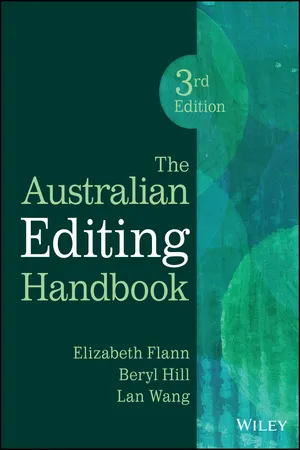
- English
- ePUB (mobile friendly)
- Available on iOS & Android
The Australian Editing Handbook
About This Book
The ultimate editing handbook, updated for the digital age
The Australian Editing Handbook has become an industry standard, recommended by the Society of Editors, and holds a prominent place on the shelves of writers, editors and students alike. Authors Elizabeth Flann, Beryl Hill and Lan Wang have assembled a comprehensive guide to every aspect of the editing process, from working with authors and receiving manuscripts, to editorial, production, printing and beyond.
The modern editor must go beyond editing and proofreading, and is often tasked with obtaining permissions, sourcing supplementary material and keeping the author on schedule and on budget. That means the editor is also the ultimate mediator of style and propriety for the piece, acting as gatekeeper between the author and the public. It's a substantial role, requiring the fundamental knowledge of several different fields to achieve effective results. A guide to managing each aspect of the job, The Australian Editing Handbook is an invaluable resource. The Third Edition includes updated information about the new challenges that editors face in the digital age, including:
- Editing on-screen
- Digital publishing
- Handling ebooks
- Print media versus online publications
The book includes two-color printing to make editing marks easier to understand, and a wealth of charts and diagrams that simplify complex topics and serve as handy quick-checks that make this guide the ultimate desk reference. For professionals and students in the field of editing, writing, publishing or journalism, The Australian Editing Handbook, 3rd Edition is the industry's number-one resource.
Frequently asked questions
Information
PART B
The basics of editing
- 3 Getting ready for editing
- 4 Parts of a book
- 5 Structural and copy editing principles
- 6 Editing practice: onscreen editing techniques
- 7 Editing practice: copy editing techniques
- 8 Editing practice: other elements
- 9 Editing practice: artwork
- 10 Specific areas of editing
Chapter 3
Getting ready for editing
SETTING UP THE WORKSPACE
a system used in Microsoft Word for electronically recording changes in word processing documents
Editing resources
- a good up-to-date dictionary, preferably the latest edition of the Macquarie Dictionary or The Australian Concise Oxford Dictionary (or the older but more comprehensive The Australian Oxford Dictionary)—if you work for a company or organisation that has a house style, it will normally specify one of these dictionaries; many editors use more than one
- the most recent Australian Style Manual for Authors, Editors and Printers (the Style Manual) or any other style guide that is required for the publication (such as The Australian Guide to Legal Citation, The Chicago Manual of Style)
- Roget’s International Thesaurus.
- Writing and style
- — The Little, Brown Handbook
- — The Handbook of Nonsexist Writing for Writers, Editors and Speakers
- — New Oxford Style Manual
- — The Elements of Style (Strunk & White)
- English-language usage
- — The Cambridge Guide to Australian English Usage
- — The New Fowler’s Modern English Usage
- English grammar
- — Rediscover Grammar
- — Penguin Dictionary of English Grammar.
Table of contents
- Cover
- Title Page
- Copyright Page
- Foreword
- About the authors
- List of figures and tables
- How to use this book
- Acknowledgements
- Part A: Introduction to publishing
- Part B: The basics of editing
- Part C: The production process
- Where to from here?
- Glossary
- Appendixes
- Index
- End User License Agreement